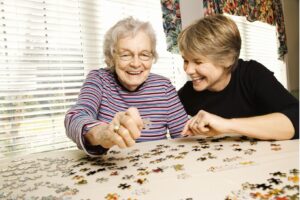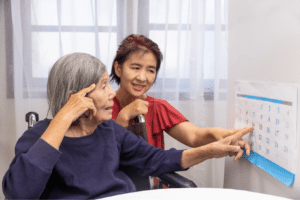 Grace was worried. She’d struggled to get by financially her entire life, working in various factories and taking overnight shifts as a nanny to make ends meet. In her early 70s, she became unable to work due to her arthritis, and Grace found herself slipping below the poverty line.
Grace was worried. She’d struggled to get by financially her entire life, working in various factories and taking overnight shifts as a nanny to make ends meet. In her early 70s, she became unable to work due to her arthritis, and Grace found herself slipping below the poverty line.
With no children to help support her financially or emotionally, Grace found aging alone very difficult for many years. So much depended on money, and though she didn’t need much, she dreamed of having a home care worker come to her one-bedroom San Francisco apartment and help her with some of her daily tasks that were becoming increasingly difficult as she lost mobility.
One day, while speaking with a dear old friend, she learned that she may be able to have Medicaid pay for her home healthcare. That’s when things really started to shift for Grace. All her life she felt that the things she wanted and needed were just slightly out of her reach, but with Medicaid and other services help, she was able to live and age comfortably and safely in her own apartment.
If you or an aging loved one live in California and could benefit from home healthcare, you may be able to get some of the costs covered by Medi-Cal, California’s version of Medicaid. In hopes of aging independently, or helping a loved one do so, let’s look at how Medi-Cal can help with medical costs associated with at-home care and what other resources are available to help reduce the financial burden.
How Much Does Medicaid Pay for Home Healthcare? Programs Based on Income and Need
Unfortunately, there is no simple answer for how much Medi-Cal will pay for home healthcare. Generally speaking, though, Medi-Cal will either provide full coverage of home healthcare costs, partial coverage, or it will pay for certain services. How much coverage an aging adult receives for services will depend on their income and their medical needs.
Once you are accepted into a Medi-Cal program, a doctor will assess your need for at-home healthcare and determine what services are medically necessary. Home healthcare services eligible for coverage under Medi-Cal include:
- Skilled nursing
- Physical therapy
- Occupational therapy/services
- Speech pathology services
Typically, the lower your income, the more coverage you receive from Medi-Cal. There are, however, programs for aging adults with higher incomes that offer partial coverage.
Share of Cost (SOC) Medi-Cal, for example, is a program for aging adults who may have higher incomes and need long-term care but still struggle with the associated expenses. Individuals who qualify for this program are expected to share the cost of their expenses with Medi-Cal and must pay for as much of their care as they can afford. Exact costs vary, as they depend on individual income.
State-Run Non-Medical Home Care Coverage Programs
While Medi-Cal does provide varying degrees of coverage for home healthcare, it does not cover long-term skilled care that isn’t necessarily medical in nature. Fortunately, In-Home Supportive Services (IHSS), however, does pay for these services for adults living at home who are 65 and older or are living with a disability. IHSS is available for individuals who qualify for Medi-Cal and who wouldn’t be able to live at home safely without the type of supportive care it provides.
Such kinds of non-medical care covered by IHSS include:
- Domestic services, such as cooking, cleaning, and laundry.
- Transportation services to and from medical appointments.
- Personal care services, such as help with bathing, eating, and grooming.
- Paramedical help, including bladder care and assistance with taking medicines
- Protective supervision care to prevent bodily harm for those with cognitive difficulties like dementia
Again, the extent of coverage is determined on a case-by-case basis.
While Medi-Cal and IHSS provide partial or fully covered medical and non-medical at-home care for many aging adults in California, there are undoubtedly people who fall through the cracks. And with the Trump Administration’s proposed healthcare bill, there are likely to be even more in the future. For these people, non-profit organizations like Institute on Aging provide a plethora of home care services so that low-income adults can live comfortably in their homes while receiving the care they need.
Life really changed for Grace once she began receiving home healthcare services and help with the tasks of daily living. It was one of the first times in her life she felt supported physically, financially, and emotionally. Even though most of her life had been difficult, she’d finally found a sense of ease in her later years—something that all aging adults deserve to experience.
At Institute on Aging, we offer a variety of resources to aging adults so that they can age healthily, happily, and safely at home. To find out more about our diverse services, contact us today.







